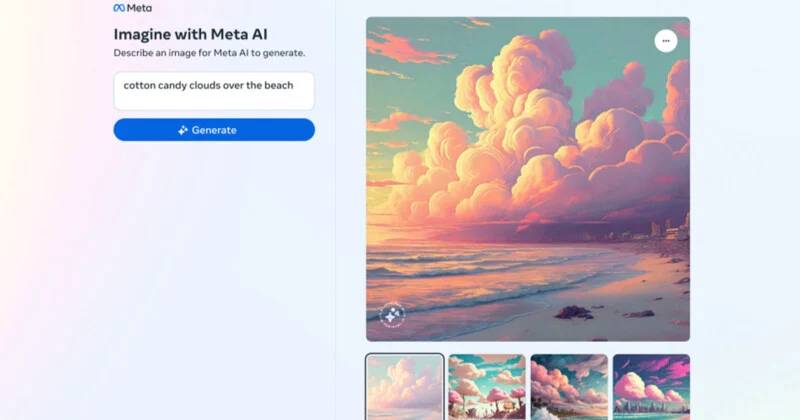In response to Google’s Gemini launch, Meta is launching Imagine with Meta, a new stand-alone generative AI web experience that lets users create images by describing them in natural language.
Imagine with Meta, which is powered by Meta’s current Emu image generating model, generates high-resolution images from text prompts in a way similar to OpenAI’s DALL-E, Midjourney, and Stable Diffusion. Users in the United States can use it for free (for the time being) and it produces four images for each prompt.
“We’ve enjoyed hearing from people about how they’re using imagine, Meta AI’s text-to-image generation feature, to make fun and creative content in chats. Today, we’re expanding access to imagine outside of chats,” Meta writes in a blog post published this morning. “While our messaging experience is designed for more playful, back-and-forth interactions, you can now create free images on the web, too.”
Now that Meta’s image generation tools have recently gotten the firm into trouble (see: Meta’s AI sticker generator that is racially biassed), this writer is left wondering if Imagine with Meta has any protections in place to make sure that history doesn’t repeat itself. Although we weren’t able to test the tool before it launched, you can be sure that we’ll be closely monitoring Imagine with Meta as it gains traction.
Meta promised to start watermarked Imagine with Meta material in the upcoming weeks for “increased transparency and traceability,” albeit they won’t go live right away. (A watermark is currently visible.) According to Meta, an AI model will be used to create the invisible watermarks, and a related model will be used to detect them. There is no information on when the detection model will be released to the general public.
In the post, Meta claimed that “[The watermarks are] resilient to common image manipulations like cropping, resizing, color change (brightness, contrast, etc.), screen shots, image compression, noise, sticker overlays and more.” “We aim to bring invisible watermarking to many of our products with AI-generated images in the future.”
Techniques for watermarking generative art are not new. Imatag, a French firm, says that its watermarking tool is not impacted by image resizing, cropping, editing, or compression. Watermarks that withstand resizing and other modifications are applied using an AI model by Steg.AI, another company. While Shutterstock and Midjourney have agreed to rules to contain marks indicating their content was developed by a generative AI tool, Microsoft and Google have adopted standards and technology for watermarking that are based on artificial intelligence.
However, there is increasing demand on technology firms to disclose that their creations were created using artificial intelligence (AI). This is especially true in light of the spread of Deepfakes from the Gaza War and the filter-bypassing of AI-generated photographs of child abuse.
China’s Cyberspace Administration has released regulations requiring that providers of generative AI label information generated by the technology, such as text and picture generators, not harm the the user experience. Additionally, Senator Kyrsten Sinema (D-AZ) highlighted the necessity of openness in generative AI during recent U.S. Senate committee hearings, including the use of watermarks.
- Top 5 Health Insurance Stocks to Add to Your Portfolio - July 26, 2024
- 7 Reasons Edamame is Great for Your Health - July 26, 2024
- 2024 Paris Olympics: How Many US Athletes Are Competing? - July 26, 2024





